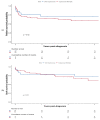Cryptococcal Meningitis in Kidney Transplant Recipients: A Two-Decade Cohort Study in France
- PMID: 35745553
- PMCID: PMC9227085
- DOI: 10.3390/pathogens11060699
Cryptococcal Meningitis in Kidney Transplant Recipients: A Two-Decade Cohort Study in France
Abstract
Cryptococcosis is the third most common cause of invasive fungal infection in solid organ transplant recipients and cryptococcal meningitis (CM) its main clinical presentation. CM outcomes, as well as its clinical features and radiological characteristics, have not yet been considered on a large scale in the context of kidney transplantation (KT). We performed a nationwide retrospective study of adult patients diagnosed with cryptococcosis after KT between 2002 and 2020 across 30 clinical centers in France. We sought to describe overall and graft survival based on whether KT patients with cryptococcosis developed CM or not. Clinical indicators of CNS involvement and brain radiological characteristics were assessed. Eighty-eight cases of cryptococcosis were diagnosed during the study period, with 61 (69.3%) cases of CM. Mortality was high (32.8%) at 12 months (M12) but not significantly different whether or not patients presented with CM. Baseline hyponatremia and at least one neurological symptom were independently associated with CM (p < 0.001). Positive serum cryptococcal antigen at diagnosis was also significantly associated with CM (p < 0.001). On magnetic resonance imaging (MRI), three patterns of brain injury were identified: parenchymal, meningeal, and vascular lesions. Although CM does not affect graft function directly, it entails a grim prognosis.
Keywords: cryptococcal meningitis; cryptococcosis; graft outcome; opportunistic infection; renal transplantation; transplant associated diseases.
Conflict of interest statement
The authors declare no conflict of interest.
Figures





References
-
- Pappas P.G., Alexander B.D., Andes D., Hadley S., Kauffman C.A., Freifeld A., Anaissie E.J., Brumble L.M., Herwaldt L., Ito J., et al. Invasive Fungal Infections among Organ Transplant Recipients: Results of the Transplant—Associated Infection Surveillance Network (TRANSNET) Clin. Infect. Dis. 2010;50:1101–1111. doi: 10.1086/651262. - DOI - PubMed
LinkOut - more resources
Full Text Sources

